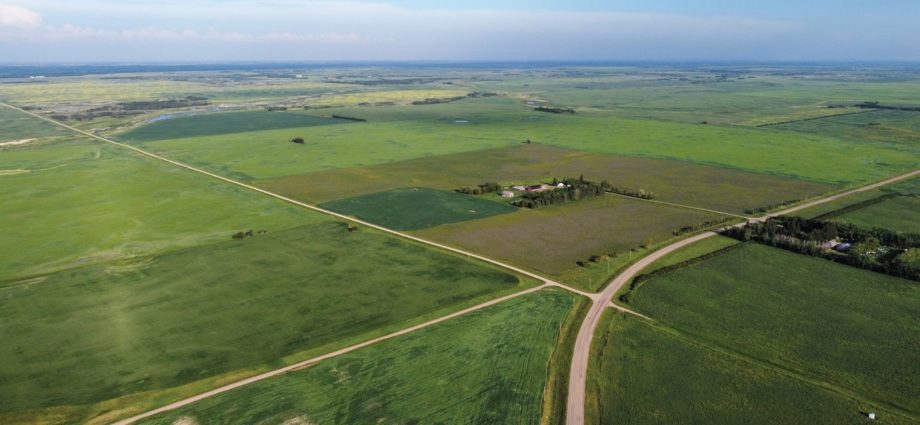
Crops growing between Moosomin and Fairlight. Sierra D’Souza Butts, Local Journalism Initiative Reporter.
By Sierra D’Souza Butts, Local Journalism Initiative Reporter, The World-Spectator
March 25, 2022
According to FCC’s 2021 Farmland Values Report there was an 8.3 per cent increase in average farmland values for Canada last year, an increase from the 5.4 per rise in values in 2020.
Saskatchewan reported an average increase of 7.4 per cent in farmland values. This came after a 5.4 per cent increase in 2020 and a 6.2 per cent increase in 2019.
Manitoba farmland values increased by 9.9 per cent during 2021, following a 3.6 per cent increase in 2020 and a 4 per cent increase in 2019.
The FCC Farmland Values Report highlighted some significant increases in average land values in several areas, with the highest recorded in Ontario of 22.2 per cent and British Columbia of 18.1 per cent. Two of the Atlantic provinces followed with increases of 15.2% in Prince Edward Island and 12.3% in Nova Scotia.
Farmland values grow in eastern Saskatchewan
While much of the Prairies were impacted by drought in 2021, Chris Préjet, appraiser for Saskatchewan at FCC, stated that farmland in eastern regions of the province increased in value because they were impacted less by the drought.
“In line with the national trend, we saw factors in with interest rates, the favorable commodity prices, they were able to somewhat offset as the farming income was not as impacted from the drought,” Préjet said.
“The east side actually saw lesser impact from that drought so the operations in that half, generally speaking, were able to take advantage of higher commodity prices with their slightly better yields. That increased farming income which increased demand, and supply wasn’t able to keep up with that demand.”
Although drought played an important role in reducing yields in some areas of the country, Préjet said eastern Saskatchewan was less impacted.
“It’s that impact from the drought, they are able to get a bigger yield than the west half might have got,” he said.
“Because of that, they (eastern regions) were able to capitalize on the higher prices which then generates more income, that then gives more purchasing power or more strength for demand, with more demand comes more competition and it leads to the higher market values that we saw this past year.”
Out of the six regions in Saskatchewan, FCC reported the east central and southeast regions as the highest increase for its average of farmland values.
The east central region increased by 11.3 per cent, averaging $1,900 per acre and the southeast region increased by 14.7 per cent, averaging $2,200 per acre, in FCC’s 2021 report.
“The southeast and east central region had better growing conditions, more timely rains that kind of thing, an overall less impact from that drought so that paired with the lower interest rates and crop insurance pay outs, they were able to generate more income and that increased that demand. Those were the main things that we saw in those two regions there,” said Préjet.
A common trend that FCC found for farmlands increasing in value in most areas in Canada, was because of high commodity prices, he said.
“Let’s say your yields are registered to what it normally would be, but then the commodity prices are higher, you’re then generating more farm income where you have more working capital, you can then use that towards your operation,” Préjet said.
“Some farmers were using that towards buying land, and with that purchasing power from that increased income, they were able to compete more for properties. That purchasing power led to more competition, with the supply staying the same but the demand increasing, that generally leads to increases in market values.”
He said the purpose of FCC’s annual Farmland Values Report is to get feedback and to help producers plan ahead.
“It’s another tool that operations can use to plan, to prepare themselves and to get a feeling about what’s going on in the markets and their areas,” said Préjet.
“They’re there locally, they do see and hear from farms in the area, they know their own markets so they use this report and on top of what they know already, to gauge where the market is going.”
Préjet was asked what he thinks the future of farmland values in Saskatchewan will be.
“I can say that our economics team does see the commodity prices being strong for the rest of the year. There is the uncertainty of how the crop season is going to go, obviously we can’t predict that, but there is some optimism going forward this year. We’ll see how things play out.”
“I think farmland values increasing throughout Canada just shows the strength of the industry really, and that’s just reflected again in Saskatchewan. There’s a strong demand which means farms are doing well overall, obviously some are facing more challenges than others but overall it just speaks to the strength of the industry.”
He said the reason why Canada increased its overall farmland values was because of higher commodity prices.
Sign Up for Our Newsletter.
“It leads back to the higher commodity prices, low interest rates and just that environment that we were in last year, those were probably the main factors that drove the market.”


